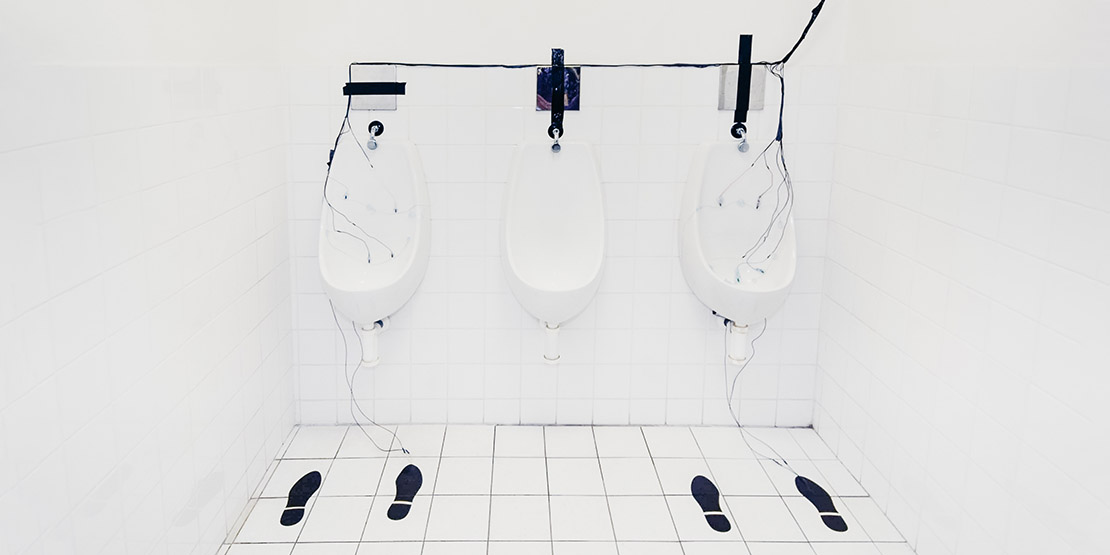- An installation that allows you to utilize the time that our society considers wasted.
- An installation that allows you not to be ashamed of hearing someone else in the bathroom.
- An installation demolishing walls not only between the toilet cabins.
- An installation that allows you to leave behind more than just a flushed toilet.
Idea
During summer 2019, I was participating in Plainair Summer Camp organized by Department of Visual Computing of Faculty of Informatics, Masaryk University Brno. The whole event was focused on exploring new possible connections between visual art and technology and pushing the limits of already known human–computer interactions. Apart from various workshops and invited talks, the main goal was to come up with a new way of H–C interaction and implement it in a team project. Although, the project, me and my colleague Petr Žemla, came up with, stood a bit aside from the other ones.
Our idea was to create an interactive urinal that would play different tones and melodies based on the aiming of a person currently dealing with his business.
Prototyping
At the very start of prototyping, we had to decide what technologies we're going to use for the whole project. As we both knew how to code and had some experience with electric circuits, we chose Arduino as the control unit.
Next step was to invent how will we control the spots triggering different melodies inside the urinal. As urine is quite a good conductor, we decided to create 8 different open circuits (one for every tone on a music scale) that became closed once a person peed on the opened part.

Another challenge was also to provide nice-sounding melodies on an 8-bit Arduino. After hours of trying different ways, we found out that the easiest way to provide quality melodies will be to connect Arduino to another device that can use an electric signal as input to output 32-bit sounds – Pocket Operator.
“The Teenage Engineering PO-12 Rhythm Pocket Operator is a powerful micro-drum synthesizer & sequencer, all packed into a small and ultra-portable design. With studio-quality sound, featuring real synthesized drum sounds, sampled drum sounds, and a variety of effects, the PO-12 is perfect for making beats on the go.”

Source: https://www.factmag.com/2018/01/25/teenage-engineering-po-35-speak-po-33-ko/
Once we finished our very first prototype, we installed it onto local urinals to test its usability with real users.
During the initial usability testing, we invited our local peers to try out our installation and then we interviewed them about their experience. We discovered couple of issues, of which the most serious one was a high conductivity of urine causing circuits to remain connected even after the business is already finished. Later on, we did two more rounds of testing before creating the final prototype.
Installation
After the final presentation of our project, we received tons of great feedback. The director of the camp appreciated our work and suggested that we could present our installation at the Prototype festival 2019 – festival connecting art, science and technology. So, we told ourselves Why not? and accepted this challenge.
During our first discussions about improvements could we provide for the festival, we immediately agreed on one goal – to make the installation sex neutral.
After days of brainstorming, drawing, programming and prototyping we decided to focus on the original idea and that was to come up with a new way of interactions.
This time we didn't choose only an innovative way of human-technology interaction but also interaction between people, in different places, doing different things, but creating mutual work of music art.
We built a second part of the installation – an electric drum set for cabins. These drums sets were hung on the toilet door so that a sitting person could drum while sitting on the toilet. We then connected both sets (playing urinals and drums) and made them into one big instrument controlled from two separate rooms – men and women toilets. All melodies are then mixed and transmitted to both rooms, therefore each participant can hear all the melodies and eventually try to cooperate to create a unique song on the spot.

Part of The Main Operating Unit
Moreover, we wanted the noises to be matching the whole authentic experience. Therefore, we decided to use unique noises created specifically for this installation. For that purpose, we recorded and edited noises that the person would be normally able to hear at a toilet and used them as samples.
Conclusion and Takeaways
The whole project was a ride. From the very beginning, we were pushed into thinking differently than in regular UX/IxD projects. We created a collaborative audio installation turning people’s time considered as “wasted” into a time they would enjoy.
What made me the happiest? During our presentation at Prototype festival 2019, I met a couple coming out of the toilets laughing and talking about the experience they’ve just been through. They both came to the toilets to do what they had to do but left it as creative beings fulfilled with joy just by interacting with strange objects at even stranger places.
